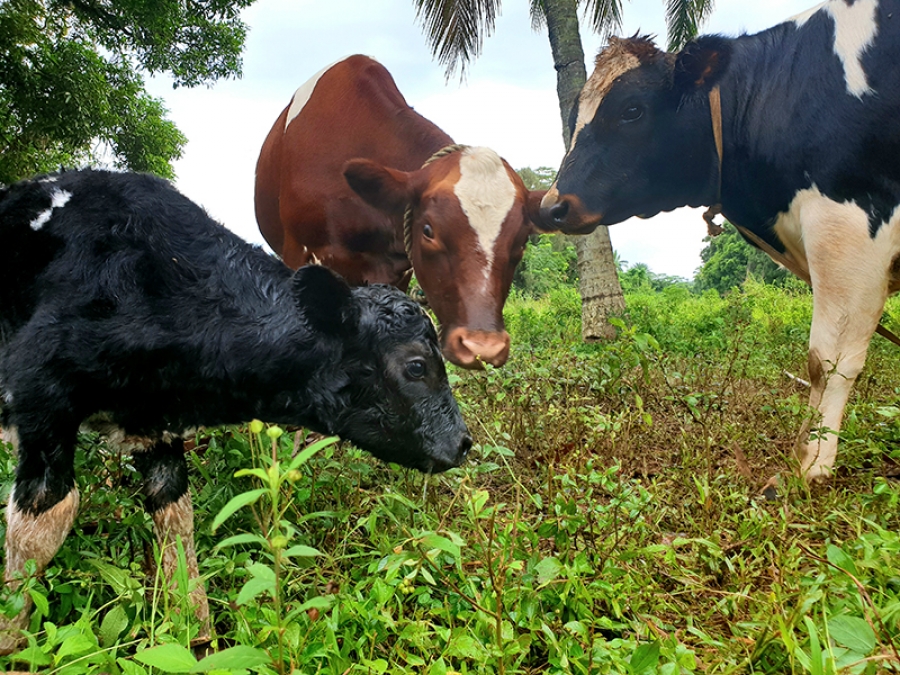PET TALK: Cattle are extraordinary
Wednesday 1 March 2023 | Written by Supplied | Published in Opinion, Pet Talk

Pictured here in this 2019 photo are a cow with calf and a yearling that a local resident said were left without water by their unknown owner. 19071512
Cattle are multipurpose. They can produce meat and milk, and make excellent tractors. They pull ploughs, they tow trailers. They harvest their own fuel and provide fertiliser in return for fuel, writes Te Are Manu clinic medical director Dr Michael Baer.
When I was about 20 there was a song, by a one-hit-wonder, called “Cows With Guns”. It had that annoying way of getting into your head and not leaving. Occupying space in your brain that could be used for something productive. And making you start humming, for no good reason. In public. It was horrible, and now I have to finish this story, while humming. Great!
Cattle are extraordinary creatures. They are some of the largest farmed animals, bulls can weigh up to one tonne or more. They are docile if handled gently. They can learn and are creatures of habit, so much so that millions of cows willingly walk onto a machine every day to be milked. Oats, almonds and soya beans also get milked. So maybe cows are not that extraordinary. But their milk does taste better (to me).
Cows eat grass. They are grazers, and use their tongues to wrap around big clumps of grass, bring it into their mouths and then cut it off with their bottom teeth and a hard pad where they should have top teeth. They chew it up, and swallow it. Once the grass is swallowed, the story gets better. It goes into the first of four stomachs a cow uses and is mixed around before being brought back to the mouth for some more chewing. Then it is swallowed again, mixed again and brought back up again, and chewed again. And again. As you may imagine this breaks even the toughest of grass into very small pieces. Then it can be moved on and more digestion happens.
Unlike sheep and some goats, cattle breed year-round. Pregnancy lasts for nine months, and calves usually stand and drink within an hour of birth. Being born back feet first is pretty normal but most calves come into the world facing forward. Calves becoming stuck, or other difficulties in delivery are not uncommon.
Worms are a big problem for calves. And can be for older cattle too. Overgrazing behind fences or repeated grazing of the same area is the usual culprit. But generally cattle have pretty robust health, provided they have adequate access to food and, especially water. Water restriction stops cattle eating, and that leads to all sorts of problems. A 10 per cent reduction in water intake can drop feed intake by half, depending on the temperature and what is being fed. Eating half what you need may be alright for a day, but not for a longer time. Bear in mind cows feeding a calf need up to 120 litres of water a day. That is quite a bit! Every day. More if it is really hot.
There are two types of cattle, and they have different traits. Bos taurus, or European breeds like Freisian or Angus, are better suited to cooler places, like Europe. Bos indicus cattle, like Brahmans, have a hump on their necks and are better suited to warmer climates. Selection of different traits from each type has resulted in lots of cross breed animals that are heat tolerant and produce more milk, or grow faster. But the best thing about these breeds are the names, like Brangus.
Cattle are multipurpose. They can produce meat and milk, and make excellent tractors. They pull ploughs, they tow trailers. They harvest their own fuel and provide fertiliser in return for fuel.
Like I said. Cattle are extraordinary.




















































